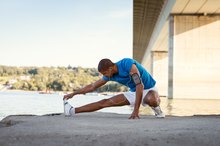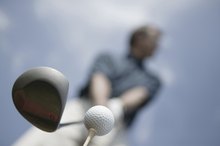How to Stop Leg Cramps When Playing Football
Muscle cramps are the result of low sodium levels in your body, and several factors can influence the development. The type of fluids you consume prior to and during exercise is important, and heat can also affect your body's internal health. Muscle cramps are minor injuries that often subside after a few minutes, but when they occur it is dangerous to use the muscle, as damage to the tissues may result. Severe cramping can also damage the muscles on its own. If you develop cramps during a football game, particularly one played in hot weather, there is an easy course of action to treat the cramp and prevent a recurrence.
If you are experiencing serious medical symptoms, seek emergency treatment immediately.
Take yourself out of the game and sit down on the sideline. Depending on the location of the cramp -- many develop in the legs -- you may need assistance to get off the field. Sit down to rest the muscle while the cramp works through itself.
How to Recover From Bad Running Leg Cramps
Learn More
Gently massage the muscle and perform light stretches to help it return to a relaxed state. Do not stretch it to the point of pain, but gradually help limber up the muscle.
Drink small amounts of a drink containing sodium. Although many associate cramping with dehydration -- and this could be a contributing factor -- you also need to replace the sodium lost from the body. Sports drinks like Gatorade and Powerade can provide your body with this sodium, helping boost sodium levels and preventing future cramps from occurring.
How to Treat a Hamstring Cramp
Learn More
Return to the field once your muscle has returned to normal and you have consumed at least 8 to 12 oz. of a sports drink.
Tips
Although bananas were long regarded as a cure for muscle cramps, this was because it was believed that cramping occurred due to a potassium deficit. Now that sodium has been identified as a culprit, eating bananas are not attributed with the same benefits as once perceived.
Warnings
Do not continue playing with a muscle if it develops pain after the cramp. This could indicate damage to the muscle.
Related Articles
References
- Young G. Leg cramps. BMJ Clin Evid. 2015;2015
- Jahic D, Begic E. Exercise-associated muscle cramp-doubts about the cause. Mater Sociomed. 2018;30(1):67-69. doi:10.5455/msm.2018.30.67-69
- Waters TR, Dick RB. Evidence of health risks associated with prolonged standing at work and intervention effectiveness. Rehabil Nurs. 2015;40(3):148-65. doi:10.1002/rnj.166
- Skogar O, Lokk J. Pain management in patients with Parkinson's disease: challenges and solutions. J Multidiscip Healthc. 2016;9:469-479. doi:10.2147/JMDH.S105857
- Hallegraeff J, De greef M, Krijnen W, Van der schans C. Criteria in diagnosing nocturnal leg cramps: a systematic review. BMC Fam Pract. 2017;18(1):29. doi: 10.1186/s12875-017-0600-x
- Mcdermott MM. Lower extremity manifestations of peripheral artery disease: the pathophysiologic and functional implications of leg ischemia. Circ Res. 2015;116(9):1540-50. doi:10.1161/CIRCRESAHA.114.303517
- Blyton F, Chuter V, Walter KE, Burns J. Non-drug Therapies For Lower Limb Muscle Cramps. Cochrane Database Syst Rev 2012; 1:CD008496.
- Grandner MA, Winkelman JW. Nocturnal leg cramps: Prevalence And Associations With Demographics, Sleep Disturbance Symptoms, Medical Conditions, And Cardiometabolic Risk Factors. PLoS One 2017; 12:e0178465.
- Allen RE, Kirby KA. Nocturnal Leg Cramps. Am Fam Physician 2012; 86:350
- American Academy of Sleep Medicine. Sleep Related Leg Cramps. In: International Classification of Sleep Disorders, 3rd ed., American Academy of Sleep Medicine, Darien, IL 2014. p.299-303.
- Maquirriain J, Merello M. The Athlete with Muscular Cramps: Clinical Approach. J Am Acad Orthop Surg 2007; 15:425.
Writer Bio
Jonathan Croswell has spent more than five years writing and editing for a number of newspapers and online publications, including the "Omaha World-Herald" and "New York Newsday." Croswell received a Bachelor of Arts degree in English from the University of Nebraska and is currently pursuing a Master's of Health and Exercise Science at Portland State University.








